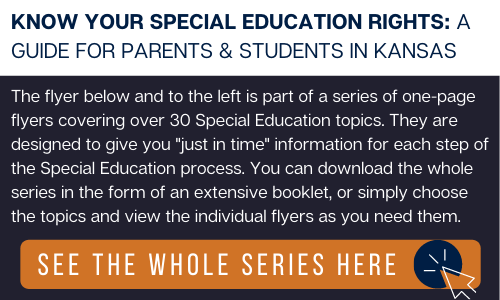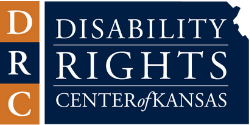Restraint & Seclusion
 |
 |
PDF Version: Restraint & Seclusion
PDF Version: Full Guide of all 30+ Flyers (Compiled as a Booklet)
Versión en Español en Formato PDF: Restricción y Aislamiento
Restraint is one form of an Emergency Safety Intervention (ESI). Kansas law allows restraint only in very limited situations. It must be an emergency situation. To be an emergency situation, the student must be actively hurting or about to hurt himself, herself or someone else. Or, the student must be significantly damaging property. Restraint is a last resort. Other things should be tried first.
Restraint is used to make a person move less. It is done when a person uses their body to stop a student from moving as much.
Not all types of touching are physical restraint. Kansas law lets school employees touch your child to offer comfort or to help them. They can briefly touch your child’s arm, wrist, or back to help guide your child to go to a safe place.
There are some things that the school can never do. When using restraint, a school CANNOT:
• Lay a student on their stomach face down
• Lay a student on their back face up
• Do anything to block a student’s airway
• Take away a student’s ability to speak - If a student speaks with their hands, like sign language, the restraint cannot involve their hands.
• Use medication to stop a student from moving. There is one exception to this. If a student is prescribed medicine for a medical condition, the school can administer the medication in the prescribed dosage.
• Use any object or device to stop a student from moving (also called mechanical restraint).
There are two exceptions to this:
- A tool or object that is ordered by a professional can be used. This might be a stabilizing or protective device that the student needs.
- A tool or object that is required by law or law enforcement can be used. Examples of these are seatbelts and handcuffs. Only a law enforcement officer can use handcuffs.
If your child has a medical condition that will put them at risk if restraint is used, then restraint cannot be used. A health care provider must write a statement that says this. It will explain your child’s diagnosis and why restraint cannot be used. It will also list things that the school could do instead of restraint. You must share that document with the school and they will put it in your child’s file.
Seclusion is another form of an Emergency Safety Intervention (ESI). Kansas law sometimes allows it in emergency situations.
Seclusion is when three things happen:
• A school employee puts a student in an enclosed area
• The area is separate from other students and adults on purpose
• The student is not allowed to leave or they think that they are not allowed to leave the area
These are some of the rules the school must follow during seclusion:
• A school employee can see and hear the student at all times
• For example: If there is a closed door and the student is alone, a window is needed to see and hear the student
• There cannot be anything dangerous in the secluded area
• The student needs enough air flow and light
• The area needs to be similar to other rooms where students go
• The student cannot be locked alone in a room
• If the room has a door that locks, it cannot stay locked if a school employee walks away from the area
This list does not include all seclusion rules.
Will the school tell me if they use restraint and/or seclusion on my child?
When restraint and/or seclusion is used with your child, the school must notify you the same day it was used. You can require a meeting with the school to discuss the use of restraint and/or seclusion on your child. Contact the school to set this meeting. The team has to meet within 10 school days of your request. The focus of the meeting is to help prevent the use of restraint or seclusion against your child in the future.
Additionally, if your child has an IEP or Section 504 plan, you can ask for a meeting with your child’s team to discuss how to prevent the need for restraint or seclusion. In the meeting, you will talk about your concerns. The team will describe what happened with the use of restraint and/or seclusion. You and the team should focus on ways to prevent restraint or seclusion in the future. This could mean evaluating your child or creating a behavioral intervention plan. If your child already has a behavioral intervention plan, the team should think about making changes.
If you find out that restraint or seclusion was used on your child and you were not told or the ESI did not follow the law, contact the Disability Rights Center of Kansas at 1-877-776-1541.
Sources & Additional Resources:
A Family Guide to the Use of Emergency Safety Interventions and Parental Rights. Families Together, Inc.
Emergency Safety Intervention (ESI) Regulations. Kansas State Department of Education.
How can I file a complaint if ESI was used on my child? Disability Rights Center of Kansas & Families Together, Inc.
What is ESI? Disability Rights Center of Kansas & Families Together, Inc.
Notifying a parent of ESI. Disability Rights Center of Kansas & Families Together, Inc.
Disclaimer: This fact sheet is not intended to provide specific legal advice. If you need legal advice, please contact an attorney. Only an attorney can give you specific legal advice based on your particular situation. We try to update our materials regularly, but the law can change frequently. This publication is based on the law at the time that it was written. Future changes in the law could make information in this fact sheet inaccurate.
.png)





